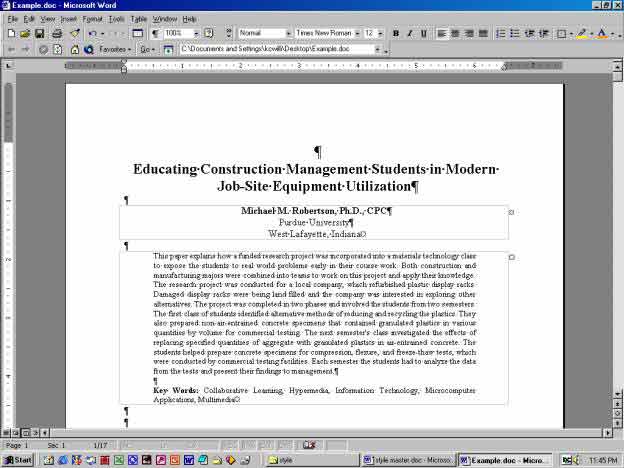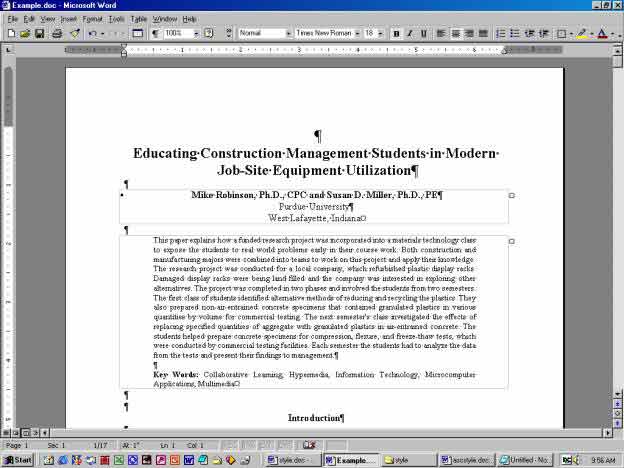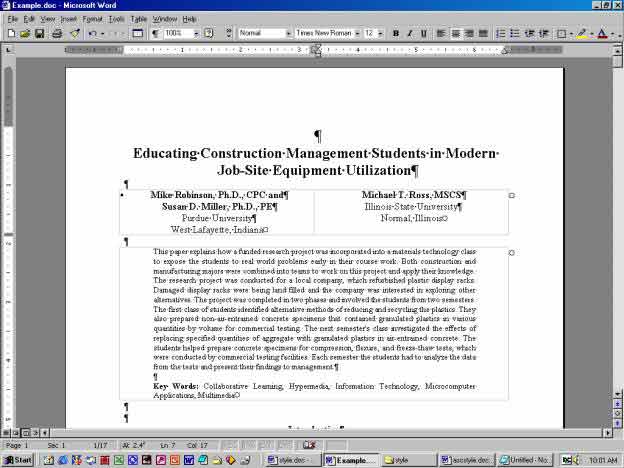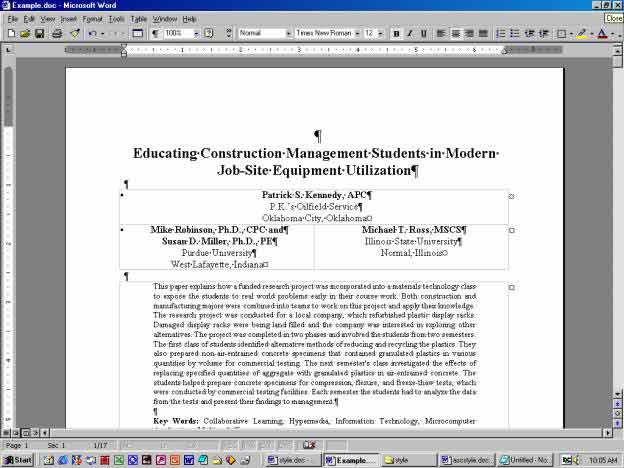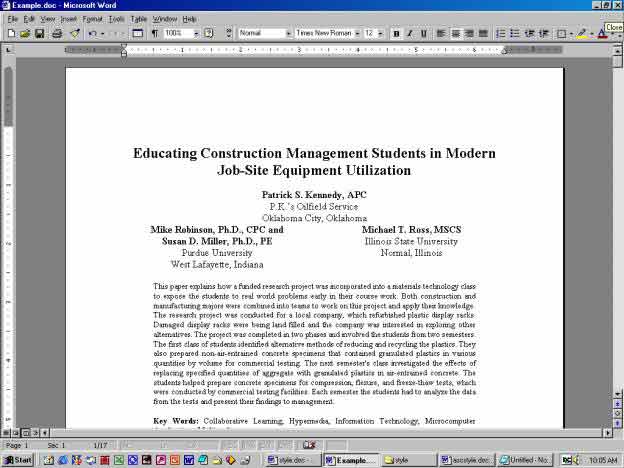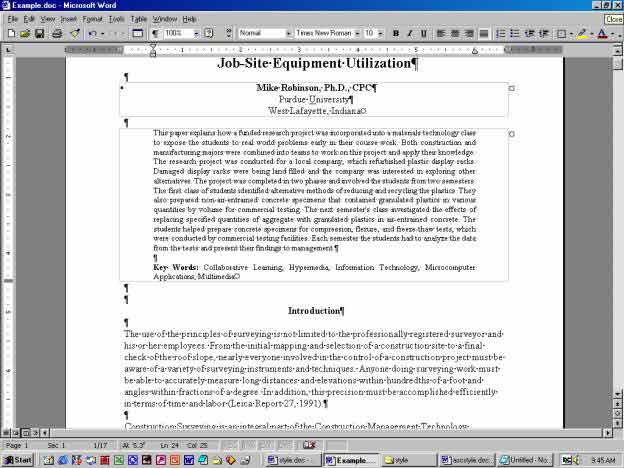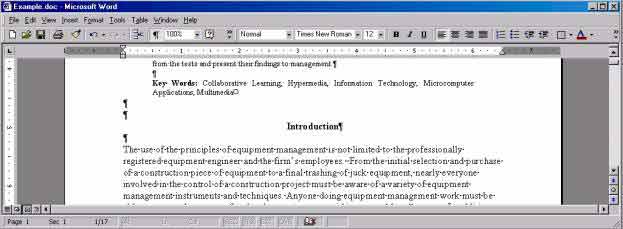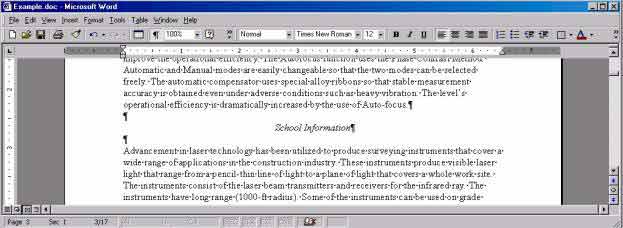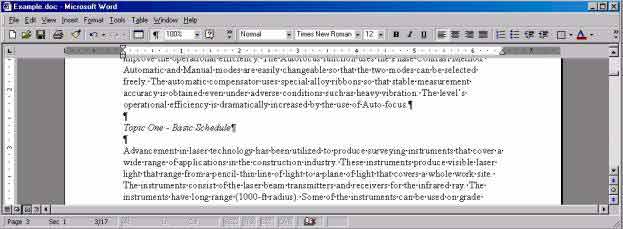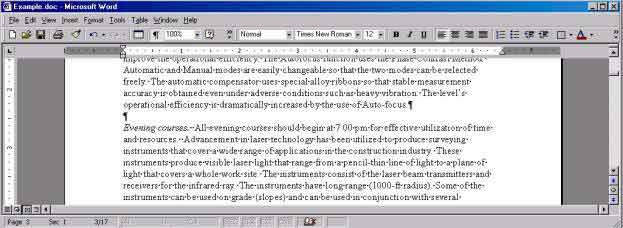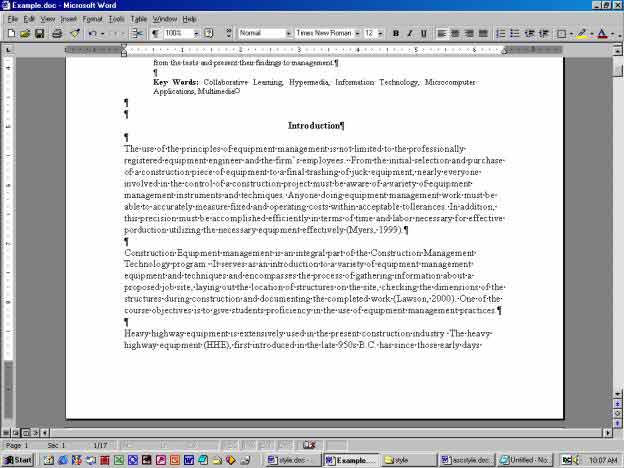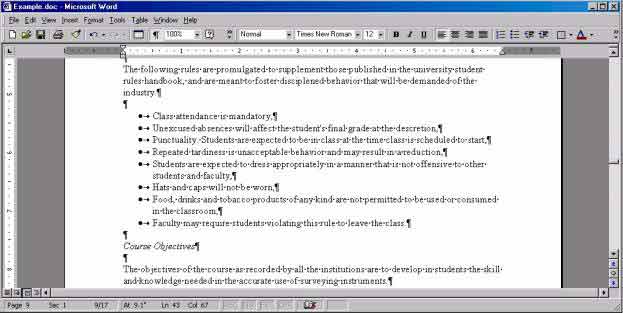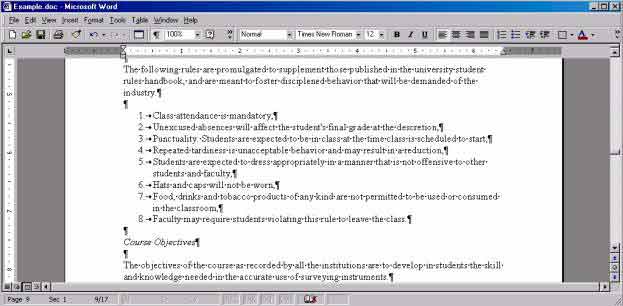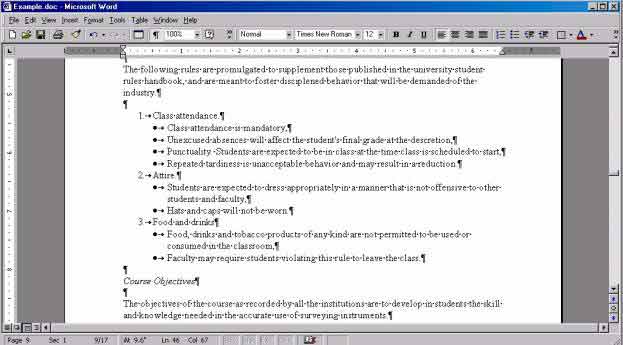Quick Manuscript
Guide Table (Link
to: ASC Journal Aims & Scope)
|
Manuscript Specifications: |
| APA Style Guide:
|
|
Where the ASC Style Guide does not provide guidance, manuscripts should conform to the Publication Manual of the American Psychological Association, 5th Edition (2001). Manuscripts also must conform to the guidelines for avoiding ethnic biases and sexist language.
|
|
Paper and Layout: |
|
Paper size will be – letter - 8½ in. x
11 in. Page orientation is to be portrait. “Layout
- section start” is set to “new page” and “vertical alignment” is to be
“top”. |
|
Margins: |
|
All margins are to be set at one inch
(1"). The gutter is set at zero inches
(0"). The header and footer are set at one-half inch (.5"). |
|
Font: |
|
Font size is 12 pt., Times New
Roman. Limit character enhancement to: bold,
underline, italics, superscript,
and subscript. Color is not
encouraged. Color may only be used if the author arranges to
do so and pays the additional publishing costs to the publisher. |
|
Paragraph: |
Example |
Each paragraph is single spaced,
aligned left only, no indents. There is only one (1) hard
return between paragraphs. |
|
Journal Paper
Length: (NEW) |
|
Manuscripts shall not exceed 20-pages
in length, including appendices. Authors of longer
manuscripts seeking a waiver of this specification may request a review
for waiver by sending their request to
asc.journal@wsu.edu. Such waivers will be given at
the editor’s discretion.
|
|
Do Not Include in Manuscript: |
|
Text Styles: |
|
Do not use any preformatted text
style. (i.e., Heading 1, Body Text) |
|
Tabs: |
|
Do not use tabs to indent text anywhere
within the document. Do not use tabs to build
tables. Use the table options of your text editor.
You may use the increase indent or decrease indent button of your text
editor. |
|
Bibliography: |
|
It is not recommended
to include works
for further reading. |
|
Footnotes or Comments: |
|
Do not use footnotes or comments within
manuscript. (Citations are to be placed within the text and
not at the bottom of the page.). |
|
Headers And Footers: |
|
No headers or footers
are to be placed
in the document. |
|
Abstract: |
Example |
Do
not include
the word "Abstract"
above the abstract
paragraph. |
|
Language: |
Example |
Language should remain non-gender
specific unless germane to the content. Do not use “he/she”, “he or she”
or like wordings. |
|
Page Numbers: |
|
Do not include page numbers in the document. |
|
Section Breaks: |
|
Do not include section or page breaks in the
document. |
|
Special Formats: |
|
Do not include date and time stamps, auto
text, fields, captions, cross-references, or indexes in the document. |
|
Body of Manuscript: |
|
Title: |
Example |
The title is one 18 pt. space from the
top of the first page. Title font size will be 18 pt., Times
New Roman, bold, centered, and upper and lower case (Title Case). The
title summarizes the main idea of the manuscript, short, and
descriptive of the contents. No hard returns are to be within the title. |
|
Author's Table: |
Example |
Author information will be formatted
within a single table, one aligned left 12 pt. hard return between the
title and the author table. The table size is established by
setting the table's width to 100%" and alignment to
"centered". Borders and shading must be set to
"none." Authors from the same institution are placed within
the same cell, joined by the word “and.” The number of cells
will depend upon the number of authors from differing
institutions. No table will be over two cells wide, but may
contain multiple rows. The first line is (bold) and contains the author’s first name,
middle initial, and surname followed by their degree i.e., Ph.D., MSCS
and certifications and licenses i.e., CPC, PE. The
second line (not
bold)
is their institutional affiliation. The third line (not bold) is their institution’s city and state. |
|
Abstract and Key Words: |
Example |
Do not include the heading "Abstract." The abstract will be
formatted within a single table, one aligned left 12 pt. return between
the author table and the abstract table. The table size is
established by setting the table's width to 100%" and alignment to
"centered". The text within the table is justified left and
right and is indented one-half inch from both side margins.
Borders and shading must be set to "none." Font is 10 pt.,
Times New Roman, and is limited to one paragraph under 200 words. No hard returns
are
to be included within the abstract. The key words are to be
included within the abstract table one hard return below the
abstract. Provide no more than five key reference words. Bold
only the text “Key
Words:”. |
|
1st Level Headings: |
Example |
Font size is 12 pt., Times New Roman,
and bold. Headings are centered, upper and lower case (Title
Case). Two (2) hard returns before the heading and one (1)
hard return after the heading. |
|
2nd Level Headings: |
Example |
Font size is 12 pt., Times New
Roman. Headings are centered, italicized, uppercase and lowercase heading, 1
line space before, and 1 line space after. |
|
3rd Level Headings: |
Example |
Font size is 12 pt., Times New
Roman. Headings are flush left, italicized, uppercase and lowercase side
heading, 1 line space before, and 1 line space after. |
|
4th Level Headings: |
Example |
Font size is 12 pt., Times New Roman
and are flush
left, italicized, lowercase paragraph heading ending with a period (.), 1 line space before, 3 character
spaces after, paragraph begins same line. |
|
Citations: |
Example |
Citations are within parenthesis,
place (author's surname and publication year) within the text at the
appropriate point. All citations must refer to sources listed in the
references, and all sources listed must be cited from within the text.
See the references examples (under the support material section of the
manuscript specifications) for proper listing of sources. |
| Tables & Figures: |
|
Tables and figures should not be embedded in the text, but should be included as separate files. |
|
Tables: |
Example |
Textual information presented in
column and row format. All tables must be created using the
table function within the same word processing system as the
manuscript. No table may be included as an image file or inserted as a
reference to another file document, i.e. Excel, Access. The
table size is established by setting the table's width to 100%" and
alignment to "centered". Table titles (use 12 pt.) Appear at
top of table (note punctuation, capitalization, and formatting
displayed by the examples) and within its own row cell.
Borders and shading must be set to "none” except the title cell, header
cells, and the last cell which should have the bottom cell boundary as
a 1/2 pt. line. Column headings can be bold.
Information within the table (except for the title cell) is to be
formatted font size 10 pt., times roman. There should be a
hard return before and after the table. Tables in excess of 40 lines in total
will be included as an appendix. |
|
Figures: |
Example |
Figures include non-text entries such as graphs, illustrations,
photos, and artwork (tables are not figures). Figures should
be drawn using a suitable drawing package and embedded within the
manuscript document. The use of color is not encouraged. Color may only be used if the
author arranges to do so and pays the additional publishing costs to
the publisher. Only .gif and .jpg file formats are
considered acceptable. Submitted images should adhere to the resolution
setting of 300 dpi. A two (2) celled table contains the
figures (center justified) and figure title (left justified).
Figures will not have borders drawn around them and should be limited
to two-thirds (⅔'s) of a page. The table size is established
by setting the table's width to 100%" and alignment to
"centered". Figure titles appear in the bottom cell of the
figure table (note punctuation, capitalization and formatting displayed
by the examples). Do not include the figure title in the
figure itself. |
| Illustrations: |
|
Illustrations submitted (line drawings, halftones, photos, photmicrographs, etc.) should be digital files. Digital files are recommended for the highest quality reproduction and should follow these guidelines:
- 300 dpi or higher
- sized to fit on journal page
- EPS, TIFF, or PSD format only
|
| Color Reproduction: |
|
Color illustrations will be considered for publication; however, the author will be required to bear the full cost involved in color art reproduction. |
|
Bullets And Numbering |
Example |
Items listed should be syntactically
and conceptually parallel to the other items in the list and should be
limited to itemized conclusions or steps in a procedure. Only
minimal round bullets or Arabic numerals are to be
used. The list is one space below the previous
paragraph and indented 0.25" and is followed by one left justified
space. Each of the separate items in the series is followed
by a comma or period. Do not force or hard text your own
bullets or numbering using tabs or indents. Use auto
formatted only. You may format them to your specific needs. |
|
Support Material for Manuscript: |
|
References: |
Example |
Alphabetical listing of sources that
were used in the research and preparation of paper. Manuscripts should conform to the Publication Manual of the American Psychological Association, 5th Edition (2001). References should be indicated in the manuscript by giving the author’s name, with the year of publication in parentheses, e. g. Jones (2004) or (Jones, 2004) as appropriate. If several publications are cited by the same author and from the same year, a, b, c, etc. should be put after the year of publication. All references cited in the text should be listed in full at the end of the paper. The use of lengthy explanatory footnotes should be kept to a minimum. |
|
Appendix: |
Example |
Appendices are labeled A, B, and C
(when there is more than one), and are placed in the order they are
first referenced in the text. Please limit number of
pages. Information within the appendix is to be formatted
font size 10 pt., Times New Roman. |
 Titles:
The
title is one 18 pt. space from the top of the first page.
Title font size will be 18 pt., Times New Roman, bold, centered, and
upper and lower case (Title Case). The title summarizes the main idea
of the manuscript, short, and descriptive of the contents. No
hard returns are to be within the title.
Example:
Titles:
The
title is one 18 pt. space from the top of the first page.
Title font size will be 18 pt., Times New Roman, bold, centered, and
upper and lower case (Title Case). The title summarizes the main idea
of the manuscript, short, and descriptive of the contents. No
hard returns are to be within the title.
Example:
 Authors:
Single Author
Author
information will be formatted within a single table, one aligned left
12 pt. hard return between the title and the author table.
The table size is established by setting the table's width to 100%" and
alignment to "centered". Borders and shading must be set to
"none." Authors from the same institution are placed within
the same cell, joined by the word “and.” The number of cells
will depend upon the number of authors from differing
institutions. No table will be over two cells wide, but may
contain multiple rows. The first line is (bold) and contains
the author’s first name, middle initial, and surname followed by their
degree i.e., Ph.D., MSCS and certifications and licenses i.e., CPC,
PE. The second line (not bold) is their
institutional affiliation. The third line (not bold) is their
institution’s city and state.
Two
authors same university: same as above except names are joined by the
connective "and" and are contained within the same table cell.
Example:
Two Authors at Different
Universities
The
table is the same as single author name only each author and
information is contained in its own table cell.
Example:
Three or More Authors
Author
tables including authors with the same and different institutions: Same
as single author name table only each author group and information is
contained in its own table cell.
Example #1a:
Example #1b: (Table borders have been hidden to
demonstrate actual example.)
Authors:
Single Author
Author
information will be formatted within a single table, one aligned left
12 pt. hard return between the title and the author table.
The table size is established by setting the table's width to 100%" and
alignment to "centered". Borders and shading must be set to
"none." Authors from the same institution are placed within
the same cell, joined by the word “and.” The number of cells
will depend upon the number of authors from differing
institutions. No table will be over two cells wide, but may
contain multiple rows. The first line is (bold) and contains
the author’s first name, middle initial, and surname followed by their
degree i.e., Ph.D., MSCS and certifications and licenses i.e., CPC,
PE. The second line (not bold) is their
institutional affiliation. The third line (not bold) is their
institution’s city and state.
Two
authors same university: same as above except names are joined by the
connective "and" and are contained within the same table cell.
Example:
Two Authors at Different
Universities
The
table is the same as single author name only each author and
information is contained in its own table cell.
Example:
Three or More Authors
Author
tables including authors with the same and different institutions: Same
as single author name table only each author group and information is
contained in its own table cell.
Example #1a:
Example #1b: (Table borders have been hidden to
demonstrate actual example.)
 Abstract and Key
Words:
Do
not include the heading "Abstract." The abstract will be
formatted within a single table, one aligned left 12 pt. return between
the author table and the abstract table. The table size is
established by setting the table's width to 100%" and alignment to
"centered". The text within the table is justified left and
right and is indented one-half inch from both side margins.
Borders and shading must be set to "none." Font is 10 pt.,
Times New Roman, and is limited to one paragraph under 200
words. No hard returns are to be included within the
abstract. The key words are to be included within the
abstract table one hard return below the abstract. Provide no
more than five key reference words. Bold only the text “Key Words:.”
Example:
Abstract and Key
Words:
Do
not include the heading "Abstract." The abstract will be
formatted within a single table, one aligned left 12 pt. return between
the author table and the abstract table. The table size is
established by setting the table's width to 100%" and alignment to
"centered". The text within the table is justified left and
right and is indented one-half inch from both side margins.
Borders and shading must be set to "none." Font is 10 pt.,
Times New Roman, and is limited to one paragraph under 200
words. No hard returns are to be included within the
abstract. The key words are to be included within the
abstract table one hard return below the abstract. Provide no
more than five key reference words. Bold only the text “Key Words:.”
Example:
 Headings:
Level 1
Headings
are font size is 12 pt., Times New Roman, and bold. Headings
are centered, upper and lower case (Title Case). Two (2) hard
returns are before the heading and one (1) hard return after the
heading.
Example:
Level 2
Headings
are font size is 12 pt., Times New Roman. Headings are
centered, italicized, uppercase and lowercase
heading, 1 line space before, and 1 line space after.
Example:
Level 3
Headings
are font size is 12 pt., Times New Roman. Headings are flush
left, italicized, uppercase and lowercase side heading, 1 line space
before, and 1 line space after.
Example:
Level 4
Headings
are font size is 12 pt., Times New Roman and are flush left,
italicized, lowercase paragraph heading ending with a period (.), 1
line space before, 3 character spaces after, paragraph begins same line.
Example:
Headings:
Level 1
Headings
are font size is 12 pt., Times New Roman, and bold. Headings
are centered, upper and lower case (Title Case). Two (2) hard
returns are before the heading and one (1) hard return after the
heading.
Example:
Level 2
Headings
are font size is 12 pt., Times New Roman. Headings are
centered, italicized, uppercase and lowercase
heading, 1 line space before, and 1 line space after.
Example:
Level 3
Headings
are font size is 12 pt., Times New Roman. Headings are flush
left, italicized, uppercase and lowercase side heading, 1 line space
before, and 1 line space after.
Example:
Level 4
Headings
are font size is 12 pt., Times New Roman and are flush left,
italicized, lowercase paragraph heading ending with a period (.), 1
line space before, 3 character spaces after, paragraph begins same line.
Example:
 Paragraphs:
Each
paragraph is single spaced, aligned left only, no indents.
There is only one (1) hard return between paragraphs.
Sentence structure requires one (1) space after a period.
Example:
Paragraphs:
Each
paragraph is single spaced, aligned left only, no indents.
There is only one (1) hard return between paragraphs.
Sentence structure requires one (1) space after a period.
Example:
 Bulleted and
Numbered Lists:
Items
listed should be syntactically and conceptually parallel to the other
items in the list and should be limited to itemized conclusions or
steps in a procedure. Only minimal round bullets or Arabic
numerals are to be used. The list is one space
below the previous paragraph and indented 0.25" and is followed by one
left justified space. Each of the separate items in the
series is followed by a comma or period. Do not force or hard
text your own bullets or numbering using tabs or indents. Use
auto formatted only. You may format them to your specific
needs.
Bulleted List
Example:
Numbered List
Example:
Bulleted and Numbered List
Example:
Bulleted and
Numbered Lists:
Items
listed should be syntactically and conceptually parallel to the other
items in the list and should be limited to itemized conclusions or
steps in a procedure. Only minimal round bullets or Arabic
numerals are to be used. The list is one space
below the previous paragraph and indented 0.25" and is followed by one
left justified space. Each of the separate items in the
series is followed by a comma or period. Do not force or hard
text your own bullets or numbering using tabs or indents. Use
auto formatted only. You may format them to your specific
needs.
Bulleted List
Example:
Numbered List
Example:
Bulleted and Numbered List
Example:
 Tables:
Tables should be submitted as seperate files. Textual
information presented in column and row format. All tables
must be created using the table function within the same word
processing system as the manuscript. No table may be included as an
image file or inserted as a reference to another file document, i.e.
Excel, Access. The table size is established by setting the
table's width to 100%" and alignment to "centered". Table
titles (use 12 pt.) Appear at top of table (note punctuation,
capitalization, and formatting displayed by the examples) and within
its own row cell. Borders and shading must be set to "none”
except the title cell, header cells, and the last cell which should
have the bottom cell boundary as a 1/2 pt. line. Column
headings can be bold. Information within the table (except
for the title cell) is to be formatted font size 10 pt., times
roman. There should be a hard return before and after the
table. Tables in excess of 40 lines in total will be included
as an appendix.
Example #1: (table borders are shown here only as
graphic representation of the table formatting and for clarity)
Tables:
Tables should be submitted as seperate files. Textual
information presented in column and row format. All tables
must be created using the table function within the same word
processing system as the manuscript. No table may be included as an
image file or inserted as a reference to another file document, i.e.
Excel, Access. The table size is established by setting the
table's width to 100%" and alignment to "centered". Table
titles (use 12 pt.) Appear at top of table (note punctuation,
capitalization, and formatting displayed by the examples) and within
its own row cell. Borders and shading must be set to "none”
except the title cell, header cells, and the last cell which should
have the bottom cell boundary as a 1/2 pt. line. Column
headings can be bold. Information within the table (except
for the title cell) is to be formatted font size 10 pt., times
roman. There should be a hard return before and after the
table. Tables in excess of 40 lines in total will be included
as an appendix.
Example #1: (table borders are shown here only as
graphic representation of the table formatting and for clarity)
Table 4
Sample
analysis of data table explicitness
|
|
|
Measurement
|
|
|
Equipment Load
|
Time
|
Distance
|
Method
|
Total
Reserve
|
|
Sand
|
1:54
hr.
|
2.5
mi.
|
2
ton dual axle
|
75%
|
|
Dirt
|
2:17
hr.
|
2.3
mi.
|
1.5
ton single axle
|
16%
|
|
Gravel
|
1:47
hr.
|
1.3
mi.
|
18
yd. Dump
|
54%
|
|
Note. The reserve values represent
the mean percentages of correctly traveled loads
|
Example #2: (table borders have been hidden to
demonstrate actual example)
Table 4
Sample
analysis of data table explicitness
|
|
|
Measurement
|
|
|
Equipment Load
|
Time
|
Distance
|
Method
|
Total
Reserve
|
|
Sand
|
1:54
hr.
|
2.5
mi.
|
2
ton dual axle
|
75%
|
|
Dirt
|
2:17
hr.
|
2.3
mi.
|
1.5
ton single axle
|
16%
|
|
Gravel
|
1:47
hr.
|
1.3
mi.
|
18
yd. Dump
|
54%
|
|
Note. The reserve values represent
the mean percentages of correctly traveled loads
|
 Figures:
Figures should be submitted as seperate files.
Figures
include non-text entries such as graphs, illustrations, photos, and
artwork (tables are not figures). A two (2) celled table
contains the figures (center justified) and figure title (left
justified). Figures will not have borders drawn around them
and should be limited to two-thirds (⅔'s) of a page. The
table size is established by setting the table's width to 100%" and
alignment to "centered". Figure titles appear in the bottom
cell of the figure table (note punctuation, capitalization and
formatting displayed by the examples). Do not include the
figure title in the figure itself. Graphs, photographs, artwork, and
illustrations should be drawn using a suitable drawing package and
embedded within the manuscript document. Color is not encouraged. Color may only be used if the
author arranges to do so and pays the additional publishing costs to
the publisher. Only
.gif and .jpg file formats are considered acceptable. Submitted images
should adhere to the resolution setting of 300 dpi.
Graphs and Illustrations
These
figures should remain in their correct place within the
document. Graphs and illustrations are embedded within a
centered table cell.
Example #1a: (table borders are shown here only as
graphic representation of the table formatting and for clarity)
Figures:
Figures should be submitted as seperate files.
Figures
include non-text entries such as graphs, illustrations, photos, and
artwork (tables are not figures). A two (2) celled table
contains the figures (center justified) and figure title (left
justified). Figures will not have borders drawn around them
and should be limited to two-thirds (⅔'s) of a page. The
table size is established by setting the table's width to 100%" and
alignment to "centered". Figure titles appear in the bottom
cell of the figure table (note punctuation, capitalization and
formatting displayed by the examples). Do not include the
figure title in the figure itself. Graphs, photographs, artwork, and
illustrations should be drawn using a suitable drawing package and
embedded within the manuscript document. Color is not encouraged. Color may only be used if the
author arranges to do so and pays the additional publishing costs to
the publisher. Only
.gif and .jpg file formats are considered acceptable. Submitted images
should adhere to the resolution setting of 300 dpi.
Graphs and Illustrations
These
figures should remain in their correct place within the
document. Graphs and illustrations are embedded within a
centered table cell.
Example #1a: (table borders are shown here only as
graphic representation of the table formatting and for clarity)
|
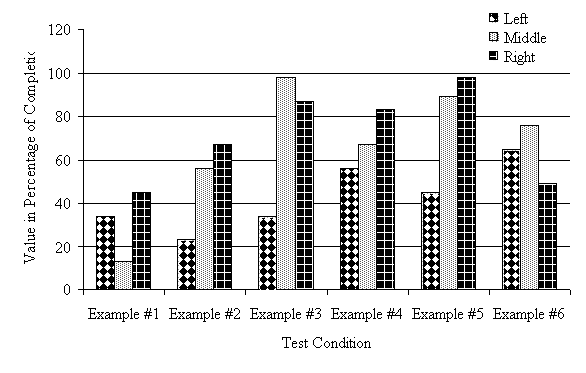
|
|
Figure 3:
Mean overall motor activity of the 374 hp. Grade changer.
|
Example #1b: (table borders have been hidden to
demonstrate actual example)
|

|
|
Figure 3:
Mean overall motor activity of the 374 hp. Grade changer.
|
Photos and Artwork
Photos and artwork are embedded within a centered
table cell in a seperate submitted file.
Example #1a: (table borders are shown here only as
graphic representation of the table formatting and for clarity)
|
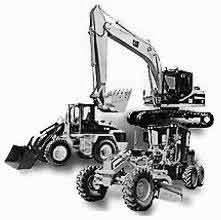
|
|
Figure 4:
Equipment source.
|
Example
#1b: (table
borders have been hidden to demonstrate actual example)
|

|
|
Figure 4: Equipment source.
|
 Citations:
Citations
are within parenthesis, place (author's surname, and publication year)
within the text at the appropriate point. All citations must refer to
sources listed in the references, and all sources listed must be cited
from within the text. See the references examples (under the support
material section of the manuscript specifications) for proper listing
of sources.
Citation Table of Contents
Examples:
Citations:
Citations
are within parenthesis, place (author's surname, and publication year)
within the text at the appropriate point. All citations must refer to
sources listed in the references, and all sources listed must be cited
from within the text. See the references examples (under the support
material section of the manuscript specifications) for proper listing
of sources.
Citation Table of Contents
Examples:
Paraphrasing:
|
. . . As written (Jones &
Moss, 1997). Or . . . As written (Jones & Moss, 1997) in the . .
|
Directly quoting:
|
". . . As written" (Jones &
Moss, 1997, p.17). Or . . . "as written" (Jones & Moss, 1997,
p.17) in the . . .
|
Citing figures and tables:
|
. . . As written (see figure 5).
. . . As written (see table 5) in the
. . .
|
 References:
The
reference list placed at the end of a journal manuscript documents the
manuscript and provides the information necessary to identify and
easily retrieve sources. Authors should choose references judiciously
and must include only the sources that directly support and
substantiate the manuscript. References must be listed in alphabetical
order according to the name of the first author and not
numbered. All sources (25 maximum) are listed alphabetically at the end
of the manuscript under the heading references.
Citation Table of Contents
References:
The
reference list placed at the end of a journal manuscript documents the
manuscript and provides the information necessary to identify and
easily retrieve sources. Authors should choose references judiciously
and must include only the sources that directly support and
substantiate the manuscript. References must be listed in alphabetical
order according to the name of the first author and not
numbered. All sources (25 maximum) are listed alphabetically at the end
of the manuscript under the heading references.
Citation Table of Contents
Style
Listing
Sources
Spacing
Indentation
Capitalization
Italicize
Punctuation
Spacing
And Punctuation
Listing Volume And Issue Numbers
Authors
Examples
Style
Listing sources
Arrange entries
in alphabetical order by the surname of the first author.
Alphabetize corporate authors, such as associations or government
agencies, by the first significant word of the name. Full
official names should be used. If there is no author, the title moves
to the title position, and the entry is alphabetized by the first
significant word of the title.
Spacing
One
hard return, aligned left, will provide a space between all entries.
Single-space each entry.
Indentation
Do
not indent paragraphs. Indent 0.25’ all bullets and numbered
listings.
Capitalization
Capitalize
all major words in the title of a journal or newspaper.
Capitalize only the first word of a manuscript's title and
subtitle. Capitalize the first word of a book's title and
subtitle, and any proper names. Capitalize the first word and
the first word of subtitles in theses, unpublished manuscripts, and
non-print media. Capitalize all names of universities and
their departments, and the names of all publishers.
Italicize
Italicize
the title of all journals, newspapers, books, theses, unpublished
manuscripts, and non-print media. Volume numbers of journals
are also to be italicized.
Punctuation
Periods
are to be placed after dates, journal, and book titles (no periods
however, between the title and parenthetical information), and at the
end of each reference entry. All abbreviations should also be
followed with a period. In a reference to a work with a
corporate author, the period follows the corporate author. In
a reference to a work with no author, the period follows the title,
which is moved to the author position. (When an author's initial with a
period ends the element, do not add an extra period.)
- Comma - use commas to separate authors and
to separate surnames and initials. Use a comma to separate the parts of
a reference entry not already separated by a period.
- Ampersand - when listing two or more authors,
use a comma, space, and ampersand (&) before the last author.
Spacing and punctuation
- after commas and semicolons: one space.
- after colons: two spaces, with the
exception of one space after the colon in two-part titles, and one
space after the colon that follows the publisher location in the
reference list.
- after periods that separate parts of a
reference citation: two spaces.
- after the periods of the initials in
personal names: one space - after internal periods in abbreviations: no
space.
Listing volume and issue numbers
In
journal references, give the volume number and italicize it.
Do not use "vol." before the number. If, and only if, each
issue begins on page 1, give the issue number in parentheses
immediately after the volume number, then follow with the page
numbers. E.g. 3, 635-647. or
27 (2), 1-7.
While
listing encyclopedias or books of several volumes, give the volume
number as (v. 1, p. 191) or (vols. 1-4) for several volumes.
Authors
Invert
all author names; give only surnames and initials of the author's first
and middle names if known.
Examples
Journal Manuscript, One Author
|
Paivio, A. (1975). Perceptual comparisons
through the mind’s eye. Memory & Cognition, 23
(3), 635-647.
|
Journal Manuscript, Two Authors
|
Becker, L. J. & Seligman, C.
(1981). Welcome to the energy crisis. Journal of Social
Issues, 37 (2), 1-7.
|
Legal Citations
Freeman Contractors, Inc. v. Central
Sur. & Ins. Corp., 205 F.2d 607 (8th Cir. 1953)
Freeman & Co. v. Bolt, 968 P.2d
247 (Idaho App. 1998)
T. Brown Constructors, Inc. v. Pena, 132
F.3d 724 (Fed. Cir. 1997)
United States v. Spearin, 248 U.S. 132,
136 (1918)
|
Magazine Manuscript
|
Gardner, H. J. (1981, December). Do
babies have a universal song? Psychology Today, 102,
70-77.
|
Newspaper Manuscript
|
Study finds free care used more.
(1982, April 3). Wall Street Journal, p. A1, A25.
|
Books, One Author
|
Bernstein, T. M. (1965). The
careful writer: A modern guide to English usage. New York:
Athenaeum.
|
Book, Two Authors
|
Strunk, W., Jr., & White, E. B.
(1979). The elements of style (3rd ed.). New York:
Macmillan
|
Edited Book
|
Letheridge, S., & Cannon, C. R. (Eds.).
(1980). Bilingual education. New York:
Praeger.
|
Videotape
|
Mass, J. B. (Producer), &
Gluck, D. H. (Director). (1979). Deeper into hypnosis
[Videotape]. Englewood
Cliffs, NJ: Prentice-Hall.
|
Eric Document
|
Smith, L. S. (1990). How
valid are GRE scores? (Report No. CSOS-R-121). Baltimore,
MD:
Johns
Hopkins
University,
Center for Social Organization of Schools. (ERIC Document Reproduction
Service No. ED 123 234).
|
Unpublished Doctoral Dissertation
|
Devins, G. M. (1981). Helplessness,
depression, and mood in endstage
renal disease. Unpublished doctoral dissertation, McGill
University,
Montreal.
|
Government document, available
from the GPO
|
National Institute of Mental Health.
(1982). Television and behavior (DHHS Publication
No. ADM 82-1234). Washington,
DC:
US Government Printing Office.
|
Electronic Format
Visiting
date: optionally, one may choose to list the date a document was
downloaded or viewed online, should there be a concern that the
document might expire in the foreseeable future. Such dates
come at the end of the reference, parenthesized in the form "(visited
year, month date)"
Note:
provided here are two examples of electronic-format examples (the first
and third examples are slightly different). Also provided are
several addresses for resources of online referencing.
Examples:
|
Beckleheimer, J. (1994). How do you
cite URL's in a bibliography? [WWW document]. URL http://www.nrlssc.navy.mil/meta/bibliography.html
|
|
Bleuel, J. (1995, November 8). Zitieren
von Internetquellen
["Citing sources on the internet"]. [WWW document]. URL http://www.uni-mainz.de/~bleuj000/zitl.html
|
|
Ivey, K. C. (1996, September 2). Citing
internet sources [WWW document]. URL http://www.eei-alex.com/eye/utw/96aug.html. Also in The Editorial Eye,
19(8), 10-11. Alexandria:
EEI.
|
|
Li, X., and Crane, N. (1996, May 20). Bibliographic
formats for citing electronic information [WWW document].
URL http://www.uvm.edu/~xli/reference/estyles.html
|
|
Quinion, M. (1996, March 10). Citing online
sources. World Wide Words: Michael Quinion
on aspects of English [WWW document]. URL http://clever.net/quinion/words/citation.htm
|
|
Tent, J. (1995, February 13). Citing
e-texts summary. Linguist List, 6(210)
[Online serial]. URL http://lamp.cs.utas.edu.au/citation.txt
|
|
Walker, J. R. (1995, April). Walker/ACW
style sheet; MLA-style citations of electronic sources
[WWW document]. URL http://www.cas.usf.edu/english/walker/mla.html
|
 Appendix:
Appendices
are labeled A, B, and C (when there is more than one), and are placed
in the order they are first referenced in the text. Please
limit number of pages. Information within the appendix is to
be formatted font size 10 pt., Times New Roman.
Example #1a: (table borders are shown here only as
graphic representation of the table formatting and for clarity)
Appendix:
Appendices
are labeled A, B, and C (when there is more than one), and are placed
in the order they are first referenced in the text. Please
limit number of pages. Information within the appendix is to
be formatted font size 10 pt., Times New Roman.
Example #1a: (table borders are shown here only as
graphic representation of the table formatting and for clarity)
|
Appendix
A
Peer
Evaluation Form
|
|
**NOTE: Complete this
form privately. This information will be used to help determine
individual contribution Grade and will not be available to anyone but
the instructor.
|
Student
Name
________________________________________________
Group Number ________________________________________________
Date
________________________________________________
I.
Distribute 17 points to the members of your group (excluding yourself)
for each of the following categories. Total points for each category
should add up to 17. A higher number point implies more
contribution and lower points implies
less contribution.
|
(Alphabetical last
name here)
|
|
1. Amount
of work contributed
|
|
2.
Attendance at group meetings
|
|
3. Quality
of individual meeting participation
|
|
4.
Completion of assigned work within schedule
|
|
5. Quality
of assigned work
|
|
6.
Individual' value and over all contribution to the group
|
|
|
II. Rank the members of
your group (excluding yourself) in the categories below. Do not place
all members in the same category.
1. Best
performer (s) _____________________________________________
2. Good performer (s)
_____________________________________________
3. Average performers (s)
__________________________________________
4. Minimal performer (s)
___________________________________________
III. Add
any comments you would like to make
|
Example #1b: (table borders are shown here only as
graphic representation of the table formatting and for clarity)
|
Appendix
A
Peer
Evaluation Form
|
|
**NOTE: Complete this
form privately. This information will be used to help determine
individual contribution Grade and will not be available to anyone but
the instructor.
|
Student
Name
________________________________________________
Group Number ________________________________________________
Date
________________________________________________
I.
Distribute 17 points to the members of your group (excluding yourself)
for each of the following categories. Total points for each category
should add up to 17. A higher number point implies more
contribution and lower points implies
less contribution.
|
(Alphabetical last
name here)
|
|
1. Amount
of work contributed
|
|
2.
Attendance at group meetings
|
|
3. Quality
of individual meeting participation
|
|
4.
Completion of assigned work within schedule
|
|
5. Quality
of assigned work
|
|
6.
Individual' value and over all contribution to the group
|
|
|
II. Rank the members of
your group (excluding yourself) in the categories below. Do not place
all members in the same category.
1. Best
performer (s) _____________________________________________
2. Good performer (s)
_____________________________________________
3. Average performers (s)
__________________________________________
4. Minimal performer (s)
___________________________________________
III. Add
any comments you would like to make
|
 Language:
Language
should remain non-gender specific unless germane to the
content. Do not use “he/she”, “he or she” or like wordings.
Example:
-
replacing . . . "men" at the jobsite . . . With . . . "workers" at the
jobsite . . .;
-
replacing . . . Information to a superintendent for "her" . . . With .
. . Information to a superintendents for" their," etc.
Language:
Language
should remain non-gender specific unless germane to the
content. Do not use “he/she”, “he or she” or like wordings.
Example:
-
replacing . . . "men" at the jobsite . . . With . . . "workers" at the
jobsite . . .;
-
replacing . . . Information to a superintendent for "her" . . . With .
. . Information to a superintendents for" their," etc.
|
